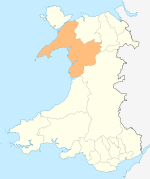Dyffryn Ardudwy
| Dyffryn Ardudwy | |
 Chambered cairn (portal dolmen) Dyffryn Ardudwy |
|
 Dyffryn Ardudwy |
|
| Population | 1,540 (2011) |
|---|---|
| OS grid reference | SH585235 |
| Community | Dyffryn Ardudwy |
| Principal area | Gwynedd |
| Ceremonial county | Gwynedd |
| Country | Wales |
| Sovereign state | United Kingdom |
| Post town | DYFFRYN ARDUDWY |
| Postcode district | LL44 |
| Dialling code | 01341 |
| Police | North Wales |
| Fire | North Wales |
| Ambulance | Welsh |
| EU Parliament | Wales |
| UK Parliament | Dwyfor Meirionnydd |
| Welsh Assembly | Dwyfor Meirionnydd |
Coordinates: 52°47′17″N 4°05′46″W / 52.788°N 4.096°W
Dyffryn Ardudwy is a village and community in the Ardudwy area of Gwynedd, Wales. It is situated on the main A496 coast road between Harlech and Barmouth. The ward had a population of 1,540 according to the 2011 census.[1]
Geography
The village of Dyffryn Ardudwy is situated on the A496 coastal road between the towns of Harlech and Barmouth and at the foot of Moelfre, part of the Rhinogydd range. The village has a railway station and a long sandy beach backed by sand dunes.[2]
History
There are a number of prehistoric cromlechs in and around the village, and they are some of the earliest tombs erected on these islands. Dating from around 4000 BC, the cairn at Dyffryn Ardudwy has two separate burial chambers.[3] One of these is a type known as a portal dolmen. A flat slab on the mountainside was used as a base, this was flanked by several other slabs, side-stones and back-stones. A capstone was placed on top and a small ovoid cairn of stones built around three sides. The fourth side was the portal and had a small forecourt. Here a pit was dug and in it were formally arranged several flat stones, various shards of pottery from at least four pots, charcoal and soil. The pit was then filled with the cairn material and the mound completed.[4]
Near Dyffryn Ardudwy is an avenue which was built by the powerful Vaughan dynasty, (who were instrumental in placing Henry VII of England on the throne in 1485), to connect their family mansion, Cors-y-gedol (The Bog of Hospitality), with the family chapel. The existing mansion was built in 1576. Nearby, the Cors-y-gedol burial chamber stands amidst the site of ancient fields and settlements and the area affords glorious views of Cardigan Bay.[5]
St Dwywe’s Church at Llanddwywe, within the community of Dyffryn Ardudwy, was built on an ancient mound which is at the end of the straight line followed by the road to Corsygedol Hall. This line runs straight and true to a cairn on the side of Moelfre, and it is suggested that this is a prehistoric man-made creation relating to the summer solstice rather than a more recent addition. The church is a Grade II listed building.[6]
Facilities
The village has a railway station served by the Cambrian Line. The village had a golf club during the early to mid-1900s.[7]
Gallery
 Cors y Gedol Mansion
Cors y Gedol Mansion- Burial chamber outskirts
- Burial chamber view
- Dyffryn Burial Chamber sign
See also
- Barmouth
- Llanaber
- List of Cadw properties
- List of Scheduled prehistoric Monuments in Gwynedd (former Merionethshire)
References
| Wikimedia Commons has media related to Dyffryn Ardudwy. |
- ↑ "Gwynedd Statistical Profile for Dyffryn Ardudwy" (PDF). 2001. Retrieved 2010-02-28.
- ↑ "Landranger 124: Dolgellau and surrounding area". 1.25 inch map. Ordnance Survey.
- ↑ Powell, T.G.E. (March 1963). "The Chambered Cairn at Dyffryn Ardudwy". Antiquity. 37 (145): 19–24.
- ↑ Thomas, Julian (2002). Time, Culture and Identity: An Interpretative Archaeology. Routledge. pp. 137–140. ISBN 978-1-134-64165-9.
- ↑ "Vaughan family of Corsygedol". Welsh Biography Online. The National Library of Wales. Retrieved 26 April 2016.
- ↑ "St Dwywe's Church Llanddwywe". Coflein. Royal Commission on the Ancient and Historical Monuments of Wales. Retrieved 26 April 2016.
- ↑ "Dyffryn Ardudwy Golf Club, Gwynedd". Golf’s Missing Links. Retrieved 26 April 2016.
